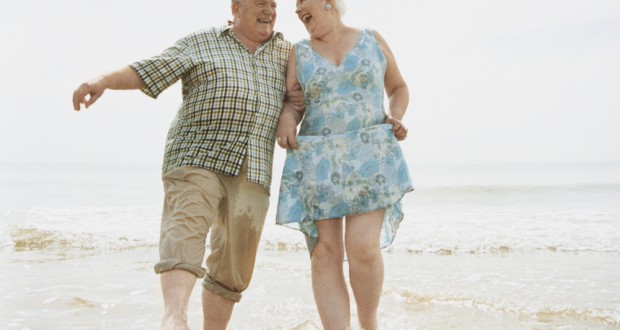A little extra weight can be quite healthy in old age; and working to lose it is generally a bad idea.
Globally, excessive weight and obesity are major health issues. The World Health Organization (WHO) reports 1.4 billion people are above their healthy weight range. Research supports the idea that being overweight generally increases risk of morbidity and mortality from conditions such as diabetes, heart disease and some cancers. However, as new research emerges, it is becoming apparent that the risks of being overweight as an older person are not the same as the risk in younger adults. Indeed, being overweight as an older adult may go some way towards promoting health.
For an illustration of this, consider the Body Mass Index (BMI). This common measure of weight status is a simple, fairly crude calculation that divides body weight in kilograms by height in meters squared (kg/m2) and classifies the result as underweight, healthy weight, overweight or obese according to set reference values.
The measure has many limitations and does not take into account gender differences, age or body composition (lean body mass versus fat mass). Nevertheless, it is now well accepted that a BMI above 25 equates to being overweight and above 30. People with a BMI above these parameters are encouraged to reduce excess body weight to prevent associated health risks. But caution is required when measuring older adults, as these parameters are not the best measure of health risk in this group. For adults above 65 years, having a BMI less than 23 is associated with an increased risk of mortality and being overweight (BMI 25–30) is not associated with increased risk of mortality. Research suggests that a healthy weight range for an older adult is around BMI 23–28, or even up to 30, which is considered overweight in general population guidelines.
Waist and waist-hip ratio measures (which are common measures in younger adults) are unreliable in older adults, as with ageing the body tends to favour central weight distribution.
Is it healthier for older adults to be heavier?
Unfortunately, with ageing many ailments, injuries and illnesses often come, taking a toll on a person’s body. This is seen time and time again when an older person is in hospital and unable to maintain their weight or when a person in the community is unintentionally losing weight. That is, they are not consciously dieting or increasing their physical activity, yet they are becoming thin and frail as the body uses up its reserves to promote recovery. Often the weight lost during illness or injury is largely muscle mass, which can be difficult for older adults to regain. For some this will be an ongoing cycle of illness, injury and weight loss that, left untreated, can result in malnutrition.
For adults who experience falls, hip fracture rates are lower in those with a higher BMI, so carrying extra weight in older adults is somewhat protective.
Weight loss is usually for younger adults only
A person’s late 60s, 70s and beyond is not the time to be focused on weight reduction for better health outcomes. Weight loss, especially through diet alone, will result in loss of muscle mass and bone density, reduced strength and mobility, increasing risk of falls and, potentially, a negative impact on the body’s immune system.
For an older adult who has diabetes or heart disease and is above healthy weight range, evidence does not support that weight loss later in life will make improvements in blood glucose or lipid levels. For those who are overweight and who suffer with joint pain, efforts to lose weight to reduce pain must be weighed up against risk of loss of strength and mobility.
Rather than promoting weight reduction through diet, pharmacotherapy or surgery, it can be beneficial for health professionals to focus on promoting positive health behaviours in a weight neutral mindset. For example, encouraging patients to include regular physical activity to promote movement and socialisation, and promoting a balanced diet with adequate protein and plenty of flavour to tantalise ageing taste buds.
In rare circumstances where it is determined that weight loss will be beneficial, a comprehensive exercise program combined with a high-protein diet is required to prevent excess loss of muscle mass. A program such as this is best overseen by a team of health professionals: a medical officer; an accredited exercise physiologist; and an accredited practising dietitian (APD).
How can nurses help?
- Be more concerned about older patients with low body weight, compared with those who are slightly overweight.
- Watch out for patients who are unintentionally losing weight – they are probably not eating enough food.
- Be aware of any stigma or weight bias – weight and BMI are just numbers. Instead, ask questions about eating and exercise habits.
- Avoid promoting weight loss in older adults unless absolutely necessary and encourage weight loss or dietary change only if this is combined with plenty of exercise and adequate protein intake.
- Consult with an APD on strategies to optimise nutritional status amongst older patients or clients.
Denise Burbidge is chief dietitian at Leading Nutrition. This article was written on behalf of the Dietitians Association of Australia.
Do you have an idea for a story?
Email [email protected]
 Aged Care Insite Australia's number one aged care news source
Aged Care Insite Australia's number one aged care news source

